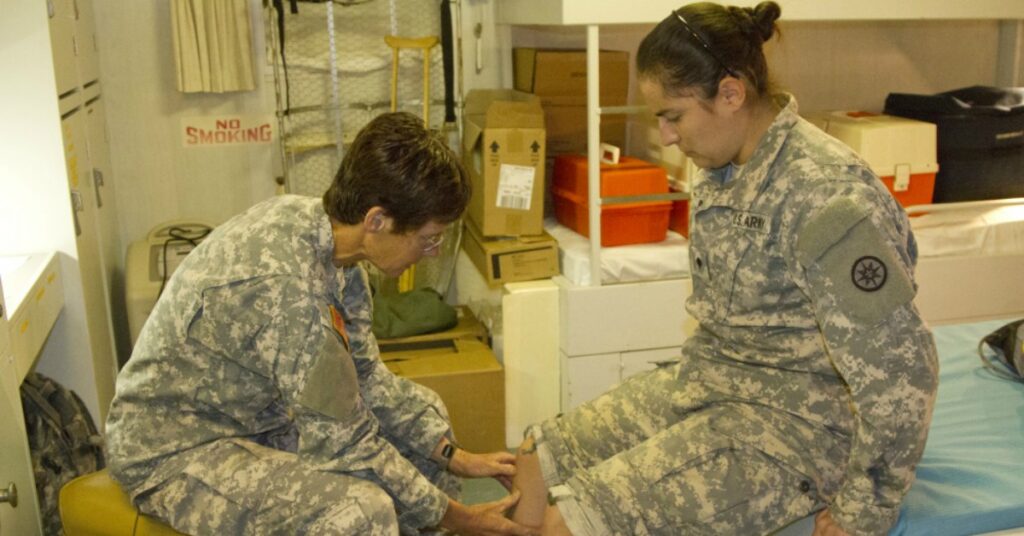Arthritis is a debilitating condition that affects millions of people worldwide. For those who are unable to work due to the severity of their symptoms, disability benefits can provide essential financial support. However, determining the level of disability caused by arthritis can be challenging. In the United States, the Department of Veterans Affairs (VA) utilizes a specific rating system to assess the impact of arthritis on a veteran’s ability to function and qualify for disability benefits. in this blog we will discuss how VA Rates Arthritis for Disability Benefits. Read on to learn more!
What is Arthritis in Veterans?

Arthritis in veterans refers to the presence of joint inflammation and stiffness among those who have served in the military. It can manifest in various forms, with osteoarthritis being the most common, caused by the wearing down of cartilage over time. Rheumatoid arthritis, an autoimmune disease characterized by chronic joint inflammation, is also observed. These conditions can result in pain, reduced mobility, and overall decreased quality of life, potentially influenced by factors like age, previous joint injuries, and the physical demands of military service.
What Are the Symptoms of Arthritis?
The symptoms of arthritis can vary depending on the type and severity of the condition. However, common symptoms of arthritis include:

1. Joint pain:
Arthritis typically causes pain in the affected joints. The pain can range from mild to severe and may be present at rest or worsen with movement.

2. Joint stiffness:
Stiffness in the joints, especially after periods of inactivity or upon waking up in the morning, is a common symptom. The stiffness may improve with movement and exercise.

3. Swelling:
Inflammation in the joints can lead to swelling, making the affected area appear larger than usual and feel tender to the touch.

4. Reduced range of motion:
Arthritis can restrict the normal range of motion in the joints, making it difficult to perform everyday tasks such as bending, gripping, or walking.

5. Joint warmth:
The affected joints may feel warm to the touch due to increased blood flow and inflammation.

6. Fatigue:
Many people with arthritis experience fatigue and a general sense of tiredness, which can be caused by the body’s immune response and chronic pain.

7. Redness:
In some cases, the affected joints may appear red or feel warm due to increased blood flow and inflammation.
It’s important to note that symptoms can vary and may come and go in flare-ups, with periods of increased symptoms followed by periods of relative relief. If you are experiencing any of these symptoms, it is recommended to consult a healthcare professional for an accurate diagnosis and appropriate management.
Is Arthritis a VA Disability?
Yes, arthritis can be considered a VA (Department of Veterans Affairs) disability if it is determined to be connected to military service. The VA recognizes that veterans may develop arthritis as a result of their service-related activities, such as combat injuries, repetitive motions, or exposure to certain environmental factors.

To qualify for VA disability benefits for arthritis, a veteran must meet specific criteria. This includes providing evidence of a current diagnosis of arthritis from a qualified healthcare professional and establishing a connection between the arthritis and their military service. The VA will review medical records, service records, and other relevant evidence to determine if there is a service-connected relationship.
If the VA determines that the arthritis is service-connected, the veteran may be eligible for disability compensation. The amount of compensation will depend on the severity of the condition and how it impacts the veteran’s ability to work and perform daily activities.
How to Prove Arthritis is Service Connected for VA Disability
To establish service connection and qualify for VA disability benefits for arthritis, there are several primary ways a veteran can prove their case:
1. Direct Service Connection for Degenerative Arthritis:
If you can demonstrate that your arthritis is directly related to your military service and is rated under Diagnostic Code (DC) 5003, you may be eligible for a disability rating of 10 percent or 20 percent, depending on the severity.
2. Direct Service Connection for Post-Traumatic Arthritis:
If your arthritis is a result of a specific injury or trauma during your military service, you can pursue direct service connection under DC 5010. This can also lead to a disability rating of 10 percent or 20 percent, depending on the evaluation.
3. Direct Service Connection for Multi-Joint Arthritis (Active Disease):
If you have active arthritis in multiple joints, you may be eligible for direct service connection under DC 5002. The disability ratings for this condition range from 20 percent to 100 percent, depending on the severity and the number of affected joints.
4. Direct Service Connection for Arthritis with Limited Range of Motion:
If your arthritis causes limited range of motion in your joints, resulting in joint pain and painful motion, you can pursue direct service connection under the DC 5200 series. The VA provides disability ratings ranging from 0 percent to 100 percent for this condition, with a rating of 10 percent assigned for painful motion in a joint.
5. Secondary Service Connection for Arthritis:
In some cases, arthritis may be linked to other musculoskeletal disorders, such as back pain. If you can establish a secondary service connection, where your arthritis is a result of or aggravated by another service-connected condition, you may be eligible for disability ratings of 10 percent or 20 percent.
Service Connection for Arthritis
Service connection for arthritis can be established through different means, depending on the circumstances.
1. Direct Service Connection:

Veterans can establish direct service connection for arthritis by demonstrating a link between the condition and an event or injury that occurred during their time in service. This can include in-service injuries, overuse of joints, or other factors. It’s important to note that the injury does not have to be traumatic, as arthritis can develop gradually over time. Medical evidence, such as documentation from a doctor, can help establish the causal relationship between the in-service event and the arthritis, potentially leading to a grant of service connection by the VA.
2. Presumptive Service Connection:

Both degenerative arthritis and rheumatoid arthritis may be eligible for presumptive service connection under certain conditions. If symptoms of arthritis manifest within one year of discharge from military service and are at least 10 percent disabling, the presumption of service connection applies. This allows veterans to establish service connection even without specific medical evidence linking their currently diagnosed arthritis to a particular incident or injury during service. The presumption serves as a shortcut to service connection, providing an avenue for eligible veterans to receive benefits.
3. Secondary Service Connection:

If a veteran’s arthritis is caused by a condition that is already service-connected, secondary service connection may be warranted. Additionally, under 38 CFR § 4.58, if a veteran is service-connected for an amputation or leg shortening, and arthritis develops later in life as a result of these conditions, it may be service-connected on a secondary basis. Arthritis can also lead to secondary conditions, such as depression, as the limitations imposed by arthritis can impact a veteran’s daily life and activities. If VA determines that the service-connected arthritis is at least as likely as not the cause of the secondary condition, secondary service connection may be granted.
VA Disability Ratings for Arthritis
The VA ratings for arthritis are outlined in the Diagnostic Codes (DC) 5003 and 5002, depending on the specific circumstances of the condition:
1. Degenerative Arthritis (DC 5003):
The rating for degenerative arthritis is based on the limitation of motion and the number of major joints or minor joint groups involved, as determined by X-ray findings. If limitation of motion is objectively confirmed, the rating is based on the specific joint or joints affected. However, if limitation of motion is non-compensable under the appropriate diagnostic codes, a rating of 10% is applicable for each major joint or group of minor joints affected. The ratings based on X-ray findings are as follows:

Arthritis with X-ray evidence of involvement of 2 or more major joints or 2 or more minor joint groups, with occasional incapacitating exacerbations.

Arthritis with X-ray evidence of involvement of 2 or more major joints or 2 or more minor joint groups.
It’s important to note that the ratings based on X-ray findings are not combined with ratings based on limitation of motion
2. Multi-Joint Arthritis (Active) (DC 5002):
This diagnostic code covers conditions such as rheumatoid arthritis, psoriatic arthritis, and spondyloarthropathies. The rating for multi-joint arthritis is based on the constitutional manifestations, weight loss, anemia, and the frequency of incapacitating exacerbations. The ratings under DC 5002 are as follows:

With constitutional manifestations associated with active joint involvement, totally incapacitating.

Less than criteria for 100% but with weight loss and anemia productive of severe impairment of health or severely incapacitating exacerbations occurring 4 or more times a year or a lesser number over a prolonged period.

Symptom combinations productive of definite impairment of health objectively supported by examination findings or incapacitating exacerbations occurring 3 or more times a year.

One or two exacerbations a year in a well-established diagnosis
Painful Motion Rule
The Painful Motion Rule is an exception to the general rule of combining ratings for different joints in cases of arthritis. This rule allows for the possibility of receiving a separate 10% rating for painful motion related to arthritis, in addition to the overall VA disability rating for arthritis.
To determine eligibility for the Painful Motion Rule, VA examiners assess pain experienced during various categories of motion, including active motion, passive motion, weight-bearing pain, non-weight-bearing pain, and range of pain and motion in the opposite, undamaged joint if available. These tests help evaluate the extent and impact of pain associated with the arthritis condition.

If you believe that the test results did not accurately reflect your experience or if you feel that the examination was incomplete, you have the right to challenge the adequacy of the exam. It’s important to provide any supporting evidence, such as documentation of pain symptoms and their impact on daily activities, to strengthen your case.
By utilizing the Painful Motion Rule, veterans can potentially receive a separate 10% rating for the pain experienced during motion, in addition to their existing VA disability rating for arthritis. This allows for a more comprehensive evaluation of the impact of arthritis on their overall disability.
Temporary 100% VA Disability Ratings
In cases where surgery is required to improve joint functionality due to arthritis, the VA offers temporary 100% disability ratings for severe medical conditions related to service-connected arthritis. If you undergo surgery as a result of your arthritic disability, the VA will adjust your rating for a temporary period to provide increased VA disability compensation for arthritis.
The temporary 100% disability rating may be granted during hospitalization and convalescence. Hospitalization ratings are assigned when a veteran is hospitalized for more than 21 days. The temporary rating begins when the veteran’s hospital stay is initiated and continues until the treatment is completed.

Convalescence ratings, on the other hand, are provided during the recovery period following surgery or another severe medical condition. To qualify for a convalescence rating, a veteran must have a post-surgery recovery time of at least one month and experience postoperative residual effects such as extended healing time or immobilization of major joints due to a cast. The convalescence rating begins one month after hospital discharge.
During the temporary 100% disability rating period, veterans receive an increased level of disability compensation to account for the impact of the surgery and recovery on their daily lives and ability to work. Once the temporary period ends, the disability rating reverts to its original level unless there have been significant changes in the veteran’s condition.
It’s important to keep the VA informed about any surgeries or medical procedures related to your service-connected arthritis. This ensures that your disability rating accurately reflects the impact of the surgery on your overall condition and helps you receive the appropriate level of compensation during your recovery.
Need help with the Disability Claim – arthritis?
If you need help with filing a disability claim for arthritis, Vet Claim Solutions can provide the assistance you need. our team of experienced vet coaches is dedicated to guiding veterans through the complex process of filing a claim and ensuring they receive the benefits they deserve. Whether you’re a veteran struggling with arthritis or you’re helping a loved one navigate the claim process, Vet Claim Solutions is here to help.
FAQs
1. How does the VA rate arthritis for disability benefits?
A: The VA rates arthritis by evaluating the severity of the condition and how it affects your ability to function. They use a rating system based on the Diagnostic Code 5003, which assigns a percentage rating for the level of disability.
2. What types of arthritis can be rated for disability benefits?
A: The VA can rate various forms of arthritis, including rheumatoid arthritis, degenerative arthritis, and other types that result in joint pain or loss of function.
3. Can I file a disability claim for arthritis?
A: Yes, if you have a diagnosed form of arthritis that is impacting your daily life, you can file a disability claim with the VA.
4. Is joint replacement surgery a qualifying condition for disability benefits?
A: Yes, joint replacement surgery can be considered as evidence of a disability and may impact the VA’s rating decision.
5. How does the VA evaluate a disability claim for arthritis?
A: The VA evaluates a disability claim for arthritis by considering factors such as the severity of joint pain, loss of motion, and the impact on daily activities.
6. What is degenerative arthritis?
A: Degenerative arthritis is a common form of arthritis that occurs due to the wear and tear on the joints over time. It often results in joint pain and stiffness.
7. Can I receive VA disability benefits for arthritis?
A: Yes, if you have a service-connected disability due to arthritis, you may be eligible for VA disability benefits.
8. How can I increase my VA rating for arthritis?
A: To increase your VA rating for arthritis, you need to provide evidence of a higher level of disability, such as frequent incapacitating episodes or evidence of painful motion.
9. How is rheumatoid arthritis rated by the VA?
A: Rheumatoid arthritis is rated under Diagnostic Code 5002, which assigns a percentage rating based on the severity of the condition and its impact on daily activities.
10. How soon should I apply for VA disability benefits for arthritis?
A: It is recommended to apply for benefits as soon as you have a diagnosed condition that is impacting your daily life. This allows the VA to assess the severity and impact of the disability more accurately.


